La Niña 2024–25
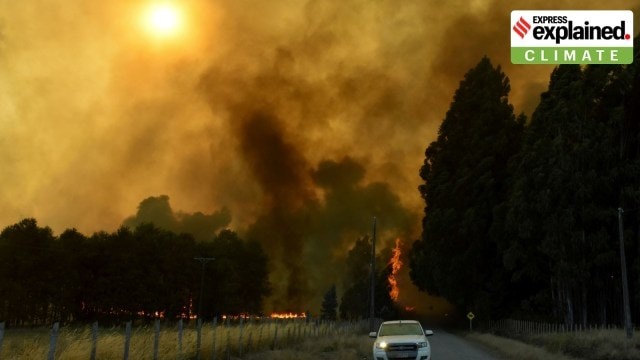
- 15 Feb 2025
In News:
Despite the expected cooling influence of La Niña, January 2025 became the hottest January on record, with global average surface air temperatures 1.75°C above pre-industrial levels (1850–1900), according to the Copernicus Climate Change Service (C3S). This marked the 18th out of the last 19 months that global temperatures exceeded the 1.5°C threshold. The inability of La Niña to curb this warming trend underscores the intensifying impact of anthropogenic climate change.
Understanding La Niña and the ENSO Cycle
La Niña, meaning "The Little Girl" in Spanish, is the cool phase of the El Niño Southern Oscillation (ENSO)—a recurring climate phenomenon involving variations in oceanic and atmospheric conditions in the central and eastern tropical Pacific Ocean.
- Phases of ENSO:
- El Niño (warm phase): Warmer ocean temperatures in the eastern Pacific, weakening trade winds and reducing rainfall in the western Pacific.
- La Niña (cool phase): Colder sea surface temperatures in the eastern Pacific, strengthening trade winds and enhancing rainfall in the western Pacific.
- Neutral phase: Sea surface temperatures are near average with no dominant anomalies.
- Mechanism: During La Niña, strengthened trade winds push warm surface waters westward, causing cold waters to upwell in the eastern Pacific. This typically results in global cooling.
- ENSO Cycle: These phases occur every 2 to 7 years and influence weather patterns globally. The ENSO cycle leads to sea surface temperature variations between ±1°C to ±3°C from the long-term average.
The 2024–25 La Niña: A Weakened Climate Driver
- Emergence: The current La Niña phase began in December 2024, later than anticipated. Forecasts had expected it around September 2024, giving it insufficient time to strengthen before its typical peak in the Northern Hemisphere winter.
- Intensity: It is projected to be a mild La Niña, reducing its capacity to significantly influence global temperatures.
- Past Events: The most recent La Niña cycle lasted from 2020 to 2023, followed by a strong El Niño through mid-2023.
- Delayed Cooling Effect: The weaker-than-usual La Niña failed to produce the anticipated cooling, surprising scientists. As Julien Nicolas from Copernicus observed, the expected “temporary brake” on global temperatures did not materialize.
Why January 2025 Remained Hot Despite La Niña
- Global Ocean Warming: Oceans have retained higher-than-usual warmth due to long-term climate change, diluting La Niña’s cooling influence.
- Weak La Niña Onset: A late and weak phase meant less disruption to the prevailing warming trend. According to NOAA, La Niña events need more time and intensity to impact temperatures effectively.
- Persistent GHG Emissions: The concentration of greenhouse gases reached record highs in 2024, adding to the Earth's heat burden. Typically, La Niña-induced rains spur vegetation growth and carbon absorption, but weaker rains in this cycle limited that effect.
- Reduced Aerosols: Declines in atmospheric aerosols—due to cleaner air policies—lessened their usual cooling impact. Aerosols scatter solar radiation and influence cloud dynamics, contributing to temperature moderation.
Global and Regional Climatic Impacts of La Niña
Despite its weak intensity, La Niña still shaped regional weather in varied ways:
Asia
- India: Higher monsoon rainfall (July–September) is expected. This boosts rice production but may reduce pulse output in the Indo-Gangetic Plain.
- Southeast Asia: Nations like Indonesia, Malaysia, and the Philippines face increased rainfall—raising flood risks but aiding rice and palm oil yields.
South America
- Southern Brazil, Uruguay, northern Argentina, and southern Bolivia face drought due to reduced rainfall, affecting soybean and maize crops.
- Northern Brazil, Colombia, Venezuela, and parts of Ecuador and Peru receive excess rain, risking floods.
Africa
- East Africa: Experiences dry conditions in December–January, hampering harvests in February–March.
- Southern Africa: Receives above-average rainfall, benefitting crops like maize, wheat, sorghum, and soybeans.
Oceania
- Australia: Faces heavy rain and possible flooding in its northern and eastern regions.
North America
- Southern US: Experiences dry conditions.
- Northern US, Canada, and Alaska face wetter, stormier weather.
Significance for India
- Agriculture: Enhanced monsoon rains improve farm productivity, especially rice.
- Water Resources: Better reservoir levels alleviate water stress.
- Energy: Increases hydropower potential.
- Heat Mitigation: Reduces severity of heatwaves compared to El Niño years.
Monitoring & Prediction
- Oceanic Niño Index (ONI): Tracks 3-month average SST anomalies. Values below –0.5°C indicate La Niña.
- Nino-3.4 Index: Confirms ENSO thresholds. Anomalies of ±0.5°C signal event onset; ±1.5°C indicates strong events.
- Tools Used: Satellite data, trade wind strength, and ocean buoys support forecasts. La Niña can be predicted up to two years in advance if preceded by a strong El Niño.
Conclusion:
The 2024–25 La Niña's inability to cool global temperatures highlights a worrisome trend—the diminishing moderating influence of natural climate phenomena. With greenhouse gas emissions continuing to rise and natural cooling cycles weakening, urgent global action is needed to reduce emissions and mitigate climate change impacts.
River Interlinking in India
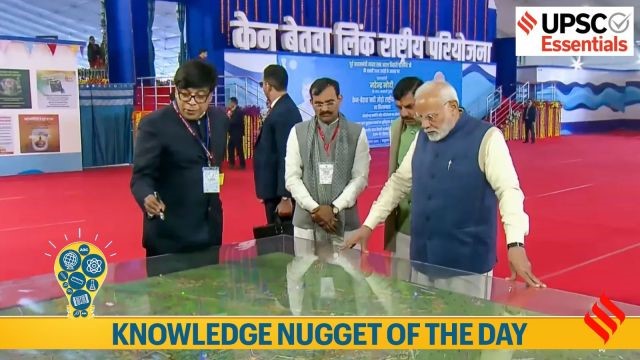
- 18 Jan 2025
Context:
India, with 17% of the world’s population but only 4% of its freshwater resources, faces significant water distribution challenges. The ambitious river interlinking project aims to mitigate regional water imbalances by transferring water from surplus areas to water-deficient regions, addressing irrigation, drinking water supply, flood control, and overall development.
Background and Evolution
The idea of interlinking rivers dates back to 1858 when British engineer Captain Arthur Cotton proposed linking rivers for inland navigation. Post-independence, Dr. K.L. Rao (1972) suggested the ‘Ganga-Cauvery Link Canal,’ followed by Captain Dinshaw J. Dastur’s ‘National Garland Canal’ proposal in 1977. However, these were deemed infeasible. In 1980, the Ministry of Water Resources formulated the National Perspective Plan (NPP), identifying 30 river link projects—14 under the Himalayan component and 16 under the Peninsular component.
The National Water Development Agency (NWDA) was established in 1982 to study and implement these projects. The Supreme Court, in response to a PIL in 2002, directed the government to expedite the completion of interlinking projects.
Ken-Betwa Link Project (KBLP)
The first project under the NPP, the Ken-Betwa Link Project (KBLP), was inaugurated on December 25, 2024. It aims to provide irrigation to Bundelkhand, one of India’s most drought-prone regions, by transferring surplus water from the Ken River in Madhya Pradesh to the Betwa River in Uttar Pradesh. Covering 10.62 lakh hectares of land (8.11 lakh ha in MP and 2.51 lakh ha in UP), the project will supply drinking water to 62 lakh people and generate 103 MW of hydropower along with 27 MW of solar power. However, environmental concerns persist as it passes through the Panna Tiger Reserve.
Significance of River Interlinking
- Water Redistribution: The scheme will transfer about 200 billion cubic meters (BCM) of water annually to water-scarce regions, ensuring equitable distribution.
- Agricultural Benefits: It will irrigate approximately 34 million hectares of farmland, enhancing food security and increasing agricultural productivity.
- Hydropower Generation: An estimated 34,000 MW of hydropower will be generated, supporting renewable energy expansion.
- Flood and Drought Mitigation: Excess water will be stored in reservoirs, reducing flood risks while ensuring availability during droughts.
- Economic Growth: Improved water availability will boost industries, generate employment, and aid in rural development.
Environmental and Social Concerns
- Ecological Disruptions: Altering river morphology can impact sediment transport, water quality, and aquatic ecosystems.
- Biodiversity Loss: Dams and canals may disrupt fish migration patterns and submerge forests, leading to biodiversity depletion.
- Climate Impact: Water transfer may affect regional climate attributes, altering temperature, precipitation, and humidity levels.
- Displacement and Social Issues: Large-scale projects often lead to displacement of communities, causing resettlement challenges and conflicts over compensation.
- Economic Viability: High project costs and potential delays raise concerns about financial feasibility compared to alternative solutions like rainwater harvesting and local water conservation.
Conclusion
While river interlinking presents a potential solution to India’s water crisis, it must be carefully assessed against environmental and social impacts. Sustainable water management strategies, such as efficient irrigation techniques and localized conservation methods, should complement large-scale projects to ensure a balanced approach to water security and development.
Bihar Under Water: An Analysis of Recurring Floods
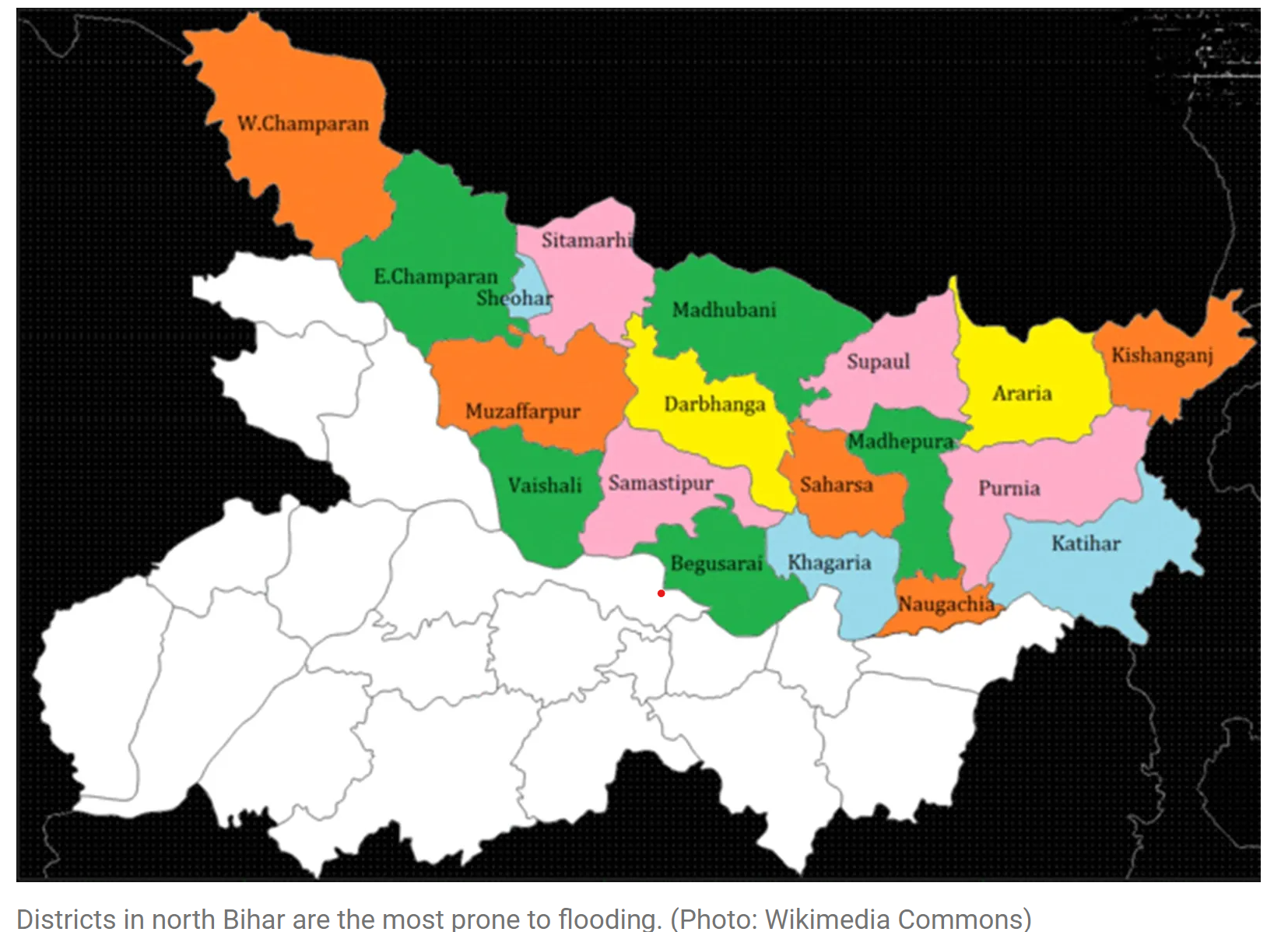
- 04 Oct 2024
Overview
Bihar is one of India's most flood-prone states, with 11.84 lakh people affected by annual flooding. The state grapples with the devastation of homes, crops, and livestock, prompting a cycle of recovery only to face similar disasters each year.
Geographical Vulnerabilities
Flood-Prone Conditions
- Demographics: 76% of North Bihar’s population lives under the threat of floods.
- River Systems: The state is crisscrossed by multiple snow-fed and rain-fed rivers, contributing to various flood types:
- Flash Floods: Rapid onset due to rainfall in Nepal (lead time: 8 hours).
- River Floods: Slower onset with a lead time of 24 hours, lasting over a week.
- Drainage Congestion: Extended flooding throughout the monsoon season (lead time: over 24 hours).
- Permanent Waterlogging: Caused by various factors including sedimentation and encroachments.
Factors Contributing to Flooding
- Himalayan Rivers: Rivers like Kosi, Gandak, and Bagmati carry significant sediment, leading to overflow during heavy rains.
- Waterlogging Causes: Silted rivers, encroachment of drainage channels, and local topographical features called Chaurs contribute to permanent waterlogging.
Historical Management Efforts
Embankments and Their Impact
- Kosi River: Known as the "sorrow of Bihar," embankments built in the 1950s to control the Kosi’s flow have led to unintended consequences.
- Sediment Accumulation: Narrowing of the river’s course has caused sediment to build up, increasing the riverbed height and flood risks.
- Current Crisis: Recent flooding was exacerbated by the release of 6.6 lakh cusec of water from the Birpur barrage in Nepal, leading to multiple embankment breaches.
Economic and Social Effects
Impact on Livelihoods
- While annual flooding may not always lead to significant loss of life, the economic repercussions are severe:
- Damage to crops and infrastructure.
- Loss of livestock and economic migration outside the state.
- Government Spending: Approximately Rs 1,000 crore is allocated annually for flood management and relief efforts.
Proposed Solutions
Structural vs. Non-Structural Approaches
- Dam Construction: Proposals for new barrages on the Kosi and other rivers have been discussed, but require cooperation from Nepal.
- Need for Comprehensive Strategies: Experts suggest a dual approach:
- Structural Solutions: Dams and embankments.
- Non-Structural Solutions: Policy development, risk mitigation, and improved community awareness.
Emphasis on Risk Reduction
- The Flood Atlas of Bihar advocates for minimizing flood risk rather than relying solely on structural measures.
- Focus on enhancing early warning systems and community preparedness is crucial for effective flood management.
Conclusion
Bihar’s unique geographical and socio-economic landscape necessitates a multifaceted approach to flood management. While structural solutions like dams are important, the state must also invest in non-structural measures that promote resilience and reduce vulnerability among its population.
Arctic Sea Ice Changes May Alter India's Monsoon Patterns
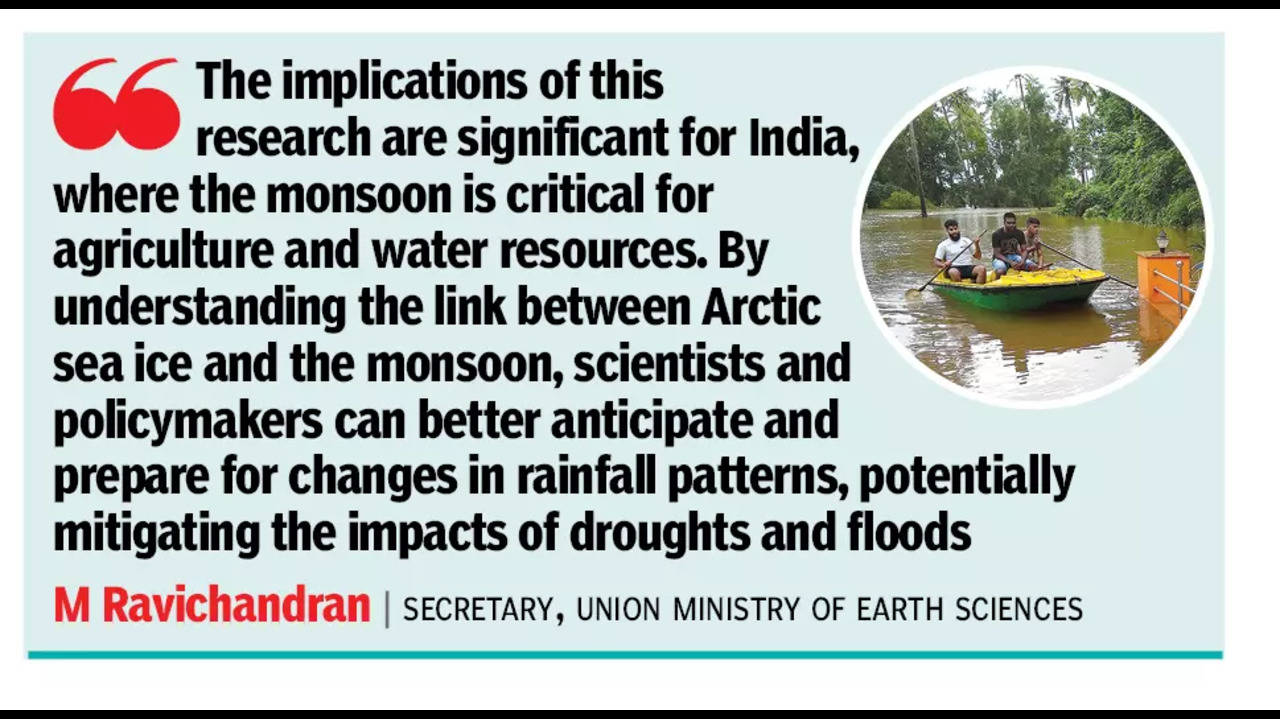
- 09 Sep 2024
In News:
A study by researchers from India’s National Centre for Polar and Ocean Research (NCPOR) has found that seasonal variations in Arctic Sea ice are impacting the Indian monsoon.
What is the Indian Summer Monsoon Rainfall?
The Indian Summer Monsoon Rainfall (ISMR), occurring from July to September, is one of the most significant monsoon systems globally. During the summer, the Central Asian and Indian landmasses heat up more quickly than the surrounding oceans. This temperature difference creates a low-pressure zone at the Tropic of Cancer known as the intertropical convergence zone (ITCZ). Trade winds from the southeast are then deflected toward the Indian subcontinent due to the Coriolis effect and the low pressure they encounter after crossing the equator. As these winds pass over the Arabian Sea, they pick up moisture and bring rain to India. The southwest monsoon divides into two branches over the Indian landmass. The Arabian Sea branch delivers rain to the west coast, while the Bay of Bengal branch brings rain to the eastern and northeastern parts of India. These branches converge over Punjab and Himachal Pradesh, with the Arabian Sea branch moving inward and the Bay of Bengal branch following the Himalayas.
Complexity of the Indian Summer Monsoon Rainfall
Recent climate models have revealed that the ISMR is influenced by the surface temperatures of the Indian, Atlantic, and Pacific Oceans. Additionally, the circum-global teleconnection (CGT), a large-scale atmospheric wave at mid-latitudes, also plays a significant role in affecting the monsoon.
Influence of Arctic Sea Ice on the Indian Monsoon
The study indicates that reduced sea ice in the central Arctic results in decreased rainfall in western and peninsular India, but increased rainfall in central and northern India. Conversely, lower sea ice levels in the upper latitudes, especially in the Barents-Kara Sea region, delay the onset of the monsoon and make it more unpredictable.
Other Atmospheric Systems Influencing the Pattern
When sea ice levels in the central Arctic rise, the heat transferred from the ocean to the atmosphere triggers cyclonic circulation at lower latitudes, such as the North Atlantic. This process enhances Rossby waves—fast-moving air currents created by Earth's rotation and temperature differences—which move from west to east. These waves cause high pressure over northwest India and low pressure over the Mediterranean region, strengthening the Asian jet stream over the Caspian Sea and shifting the subtropical easterly jet northward. This shift leads to increased rainfall in western and peninsular India. On the other hand, decreased sea ice in the Barents-Kara Sea generates an anticyclonic circulation (clear skies) over northwest Europe. This disturbance affects the upper atmosphere over subtropical Asia and India, resulting in increased rainfall in northeastern India while leaving central and northwest regions drier.
Role of Climate Change
Climate change accelerates the reduction of Arctic sea ice, which intensifies the variability and unpredictability of the ISMR. Lower Arctic sea ice contributes to more frequent and severe droughts in some areas, while causing excessive rainfall and flooding in others. The study underscores the urgent need for expanded research on climate dynamics and more accurate monsoon forecasts to address these changing patterns.
La Niña Delays and Its Impact on India’s Weather
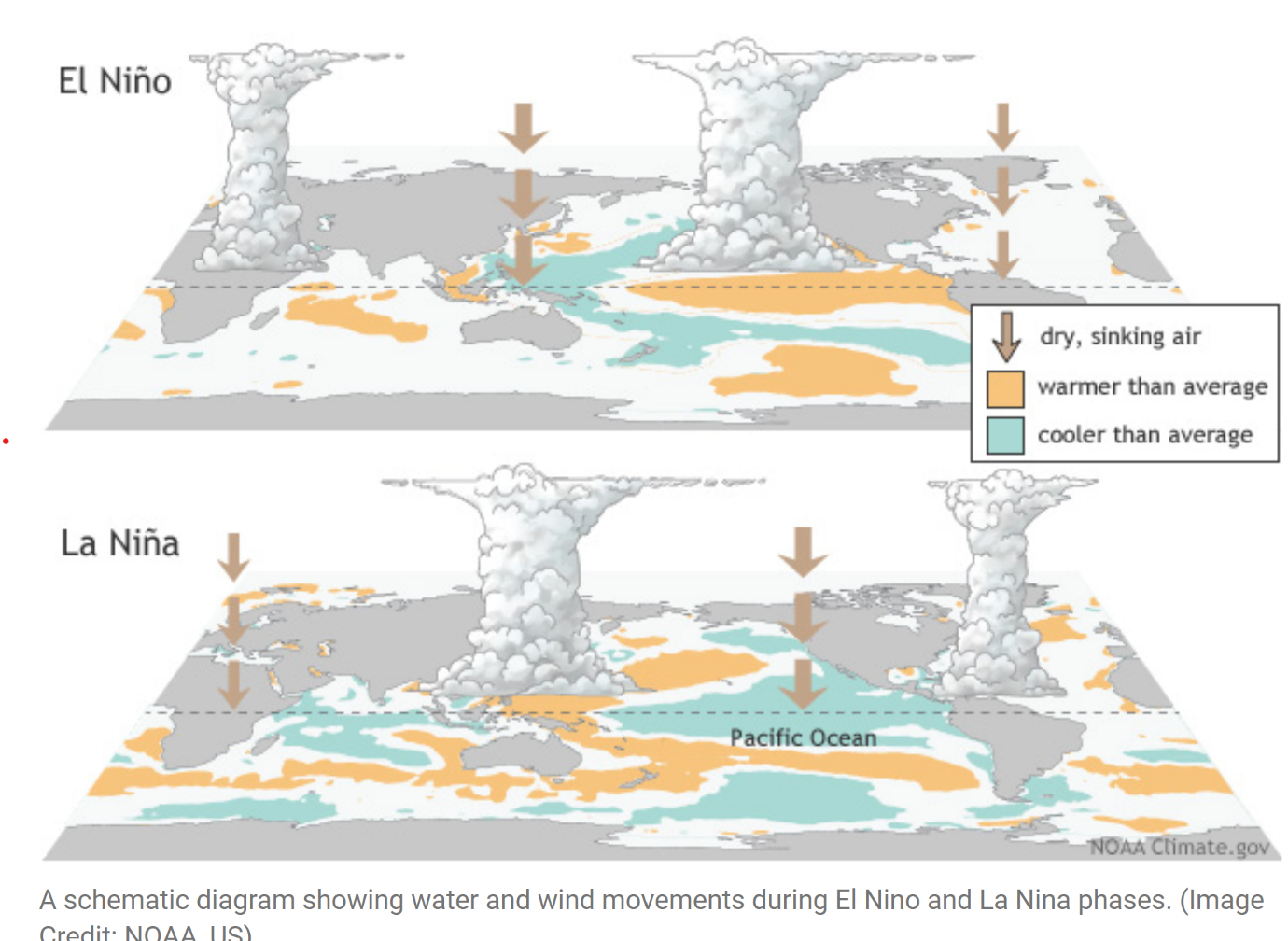
- 07 Sep 2024
- Current Conditions:
- The India Meteorological Department (IMD) reported neutral Indian Ocean Dipole (IOD) conditions.
- La Niña is expected to develop towards the end of the monsoon season, around the end of this month.
- Forecasting Challenges:
- Major global agencies have struggled with accurate forecasts for La Niña’s onset this year.
- Initial predictions suggested La Niña would start around July, but it has been delayed.
- Understanding La Niña:
- La Niña, meaning "The Little Girl" in Spanish, is a phase of the El Niño Southern Oscillation (ENSO).
- ENSO influences global climate through changes in tropical Pacific Ocean sea surface temperatures.
- ENSO phases:
- El Niño (warm phase)
- La Niña (cool phase)
- Neutral
- ENSO Phases Explained:
- Neutral Phase: Eastern Pacific is cooler; trade winds drive warm water westward, causing upwelling of cooler waters.
- El Niño Phase: Weakened trade winds result in warmer eastern Pacific waters.
- La Niña Phase: Strengthened trade winds push more warm water to the western Pacific, cooling the eastern Pacific.
- Impact on India:
- El Niño typically reduces monsoon rainfall; La Niña generally enhances it.
- The previous El Niño occurred from June 2023 to May 2024.
- La Niña episodes can influence severe weather patterns and are linked to higher temperatures, heavy precipitation, and droughts.
- Weather Model Predictions:
- A strong El Niño ended in June, transitioning ENSO to neutral.
- Global models initially forecasted La Niña for July but revised this to August-October.
- IMD’s forecast since April predicted La Niña in the latter half of the monsoon season, aiming for enhanced rainfall in August and September.
- Reasons for Delayed Onset:
- The expected La Niña might be weak, complicating predictions.
- Other atmospheric factors, including the Madden-Julian Oscillation, impact weather models.
- Current and Future Impacts:
- La Niña's first signs are expected by late September or early October.
- It is projected to peak in November and continue through the northern hemisphere winter.
- Monsoon Impact: La Niña’s delayed onset means it won’t significantly affect the current southwest monsoon, though India saw a 16% surplus in August rainfall and a forecast of 109% “above normal” rain for September.
- Potential Effects:
- Northeast Monsoon: La Niña could influence the northeast (winter) monsoon (October-December), impacting Tamil Nadu, coastal Andhra Pradesh, Rayalaseema, south interior Karnataka, and Kerala. While La Niña typically doesn’t favor northeast monsoon rainfall, exceptions have occurred.
- Cyclone Activity: La Niña years often see increased cyclone activity in the north Indian Ocean, with higher intensity and longer-lasting storms.
- Winter Weather: Historically, La Niña years lead to harsher and colder winters, suggesting a potentially severe winter ahead.
Freshwater Quest: The Emergence of the New Gold Rush
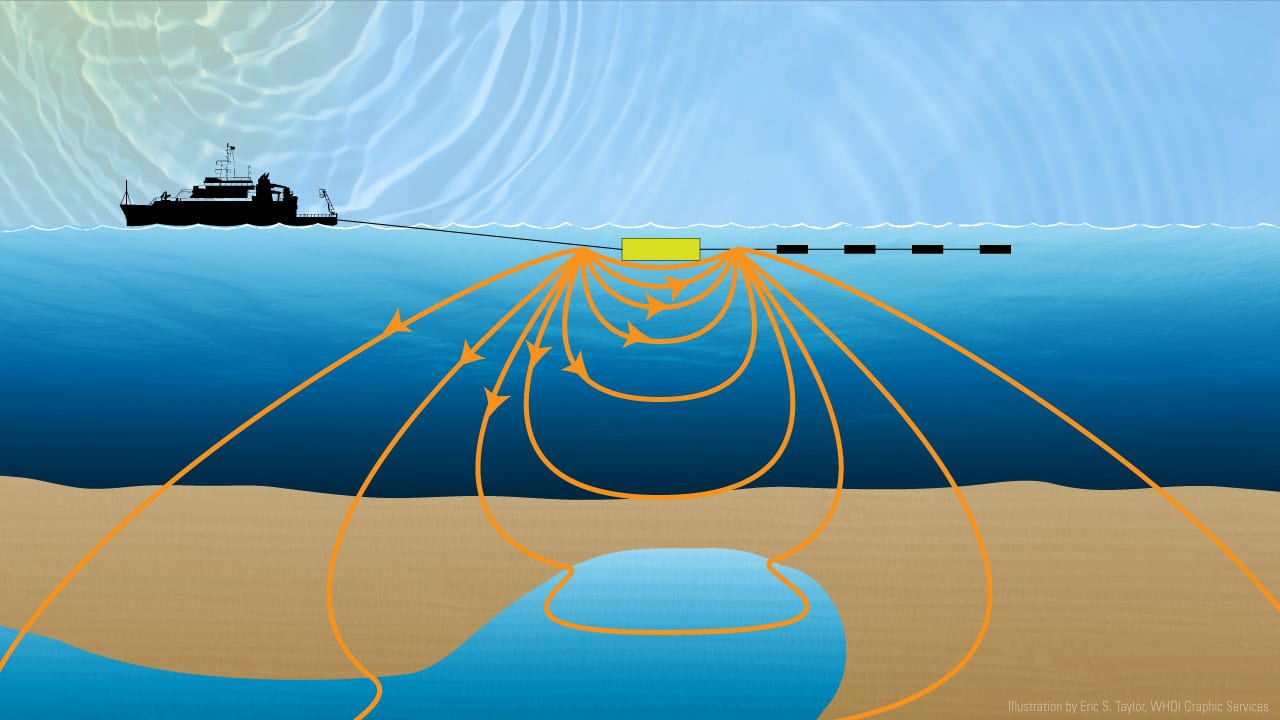
- 11 May 2024
Why is it in the News?
India can take the lead in shaping non-controversial legislative text that addresses the gaps in the laws of the sea, especially in exploratory activities that concern freshwater extraction.
Context:
- Recent statistics reveal that the vast majority of Earth's water is saline, leaving only a small portion as freshwater. Surprisingly, just 0.3% of this freshwater exists in liquid form on the surface, highlighting the significance of subterranean freshwater reserves, including those beneath the ocean floor.
- This emphasizes the growing importance of underground freshwater resources amid the escalating scarcity of surface water.
What are Undersea Freshwater Reserves?
- Undersea freshwater reserves are large volumes of fresh water found beneath the ocean floor.
- In the 1960s, the U.S. Geological Survey made an unexpected discovery of freshwater reserves beneath the ocean floor while drilling off the coast of New Jersey.
- This finding has since been followed by international scientific teams uncovering additional sources of underwater freshwater across the globe, notably including a deep river at the bottom of the Black Sea.
- This particular underwater river is over 100 feet deep, flows at a rate of about four miles per hour, and boasts a volume comparable to some of the world's largest land-based rivers.
- As freshwater resources on land become increasingly scarce, countries are turning their attention towards exploring and potentially exploiting both surface and subsurface freshwater reserves within their maritime zones.
- It is anticipated that these efforts may eventually extend beyond national Exclusive Economic Zones into regions governed by the United Nations Law of the Sea Convention, highlighting the significance of this valuable resource and the increasing need for its sustainable management.
Legal and Policy Framework of Ocean Governance:
- United Nations Convention on the Law of the Sea (UNCLOS): The United Nations Convention on the Law of the Sea (UNCLOS) serves as the primary legal framework governing the management and constitution of the world's oceans.
- It incorporates most internationally recognized maritime laws while also acknowledging the importance of customary international law in sea governance.
- UNCLOS designates the "Area" beyond national jurisdiction as the seabed, ocean floor, and subsoil, defining it as the common heritage of mankind.
- This classification underscores the notion that these regions should be available for the benefit of current and future generations.
- 1958 Geneva Conventions: The 1958 Geneva Conventions on the Law of the Sea also play a vital role in maritime legal doctrine.
- These include the Convention on the Territorial Sea and the Contiguous Zone, the Convention on the High Seas, the Convention on Fishing and Conservation of the Living Resources of the High Seas, and the Convention on the Continental Shelf.
- These Geneva Conventions address many issues similar to those covered by UNCLOS and draw their principles from customary international law, reinforcing the essential foundations of maritime legal norms.
- Exclusive Economic Zones and the "Area" under UNCLOS: UNCLOS delineates Exclusive Economic Zones (EEZs) extending up to 200 nautical miles from coastal boundaries, granting states exclusive rights to marine resources within this zone.
- Beyond the EEZ lies the "Area," designated as the common heritage of mankind, managed collectively for sustainable utilization.
Navigating Complexities in UNCLOS and Geneva Conventions:
- The United Nations Convention on the Law of the Sea (UNCLOS) and the 1958 Geneva Conventions on the Law of the Sea present complex legal interplays due to varying degrees of ratification and overlapping jurisdictions.
- For instance, UNCLOS supersedes the Geneva Conventions for its signatories but does not apply to non-signatory states.
- This divergence in international agreements is exemplified by the United States, which is a signatory to the Geneva Conventions but not UNCLOS.
- The term "resources" under UNCLOS is limited to solid, liquid, or gaseous mineral resources found in the Area.
- However, it remains unclear whether this definition extends to freshwater. Given the increasing scarcity of freshwater resources, potential conflicts may arise over its exploration and extraction in the "Area," particularly in the absence of specific legislation governing resources beyond national jurisdiction.
- The complex legal landscape is further exacerbated by the presence of multiple pieces of maritime legislation that fail to address emerging challenges effectively.
- Additionally, the regulatory authority of the International Seabed Authority (ISA) under UNCLOS adds another layer of complexity, as it remains unclear who regulates state parties to the Geneva Conventions regarding mining and exploratory activities in the "Area.
Significance of Freshwater Exploration for the Future:
- Addressing Scarcity: Given that merely 0.3% of Earth's freshwater is readily available on the surface, the exploration of underground and underwater sources emerges as imperative to satisfy future water demands.
- Conflict Prevention: As freshwater scarcity intensifies, the exploration and protection of underwater sources serve as proactive measures to mitigate potential conflicts over water resources.
- Promoting Sustainability: Engaging in responsible freshwater exploration aligns with Sustainable Development Goals, fostering the sustainable utilization of natural resources to ensure their availability for future generations.
Way Forward:
- Legislative Clarity: It is crucial to create a thorough legal framework that addresses the difficulties of discovering freshwater reserves outside of national borders.
- This framework should harmonize UNCLOS provisions with customary international law, ensuring clarity and consistency in governing maritime activities.
- International Collaboration: Engaging in constructive dialogue and negotiation forums, nations can strive to reconcile divergent legal interpretations and foster mutual understanding.
- Establishing multilateral agreements and protocols can enhance cooperation and coordination in managing underwater freshwater resources.
- Research and Technological Advancement: Investment in research and technological innovation is crucial for unlocking the full potential of underwater freshwater reserves.
- Advanced exploration techniques and sustainable extraction methods can optimize resource utilization while minimizing environmental impact.
- India's Leadership Role: As a pivotal stakeholder in maritime affairs, India can spearhead international discourse on freshwater exploration.
- By advocating for inclusive and equitable approaches, India can contribute to the development of global norms and standards governing underwater resource management.
Conclusion
The increasing scarcity of freshwater underscores the urgent need for an internationally recognized legislative framework to govern the exploration and exploitation of underground freshwater resources. The establishment of such a framework would not only help prevent potential conflicts but also ensure the sustainable utilization of this vital resource for the benefit of both present and future generations on a global scale. By proactively addressing these challenges, nations can work together to secure the long-term availability and equitable distribution of freshwater, fostering stability and prosperity in an increasingly water-scarce world.
Heat Waves and its Impacts in India

- 02 Apr 2024
Why is it in the News?
The India Meteorological Department (IMD) has forecast a harsh and arid summer over a majority of regions of the country during April- June, with a high probability of heatwave episodes lasting as long as 10 to 20 days during the period.
Recent Prediction by India Meteorological Department (IMD):
- Extreme Heat Outlook: India is anticipated to face extreme heat from April to June, with central and western regions likely to be most affected.
- Expectations of 10 to 20 heatwave days across the country, exceed the normal range of four to eight days.
- Regions including Gujarat, central Maharashtra, north Karnataka, Rajasthan, Madhya Pradesh, Odisha, north Chhattisgarh, and Andhra Pradesh are forecasted to experience severe heatwaves in April.
- Pre-Monsoon Rainfall Performance: Below-average pre-monsoon rainfall is expected this month, particularly impacting coastal, eastern, and southern India.
- El Nino Conditions: El Nino conditions, marked by abnormal sea surface warming in the equatorial Pacific Ocean since last June, have the potential to reduce rainfall and increase temperatures, both locally in India and globally.
- Despite El Nino conditions easing after peaking in December, persistent warm conditions continue to elevate global temperatures.
- Recent Weather Conditions: February and March witnessed hotter-than-normal weather in southern India.
- Heatwave conditions were reported in Maharashtra, northern Karnataka, Saurashtra-Kutch, and parts of Rajasthan during late March.
- Maximum temperatures soared to 42.6 degrees Celsius in areas such as Akola in Maharashtra and Phalodi in Rajasthan.
What are Heat Waves?
- Heatwaves entail prolonged periods of exceptionally hot weather, posing adverse effects on human health, the environment, and the economy.
- Given India's tropical climate, the nation is especially susceptible to heat waves, which have witnessed increased frequency and intensity in recent times.
What is the Criterion for Declaring a Heat Wave?
For Plains and Hilly Regions:
- Heatwave is recognized when the maximum temperature of a station reaches at least 40°C or higher for Plains and at least 30°C or higher for Hilly regions.
- Determined based on Departure from Normal Heat Wave:
- Departure from normal temperature ranges from 4.50°C to 6.40°C, with anything exceeding 6.40°C classified as a Severe Heat Wave.
- Alternatively, based on Actual Maximum Temperature Heat Wave:
- A heat wave is declared when the actual maximum temperature equals or exceeds 45°C, while a Severe Heat Wave is acknowledged if the actual maximum temperature equals or exceeds 47°C.
- Declaration occurs when the above criteria are met in at least 2 stations within a Meteorological subdivision for a minimum of two consecutive days, with the declaration taking effect on the second day.
For Coastal Areas:
- A heat wave may be identified when the maximum temperature departure from normal is 4.50°C or more, provided the actual maximum temperature registers at 37°C or higher.
Fatality Risk:
- While high temperatures alone may not be lethal, it's the conjunction of elevated temperatures and humidity, known as the wet bulb temperature, that renders heatwaves perilous.
- Increased moisture levels impede sweat evaporation and hinder body cooling mechanisms, leading to a rapid rise in internal body temperature, frequently resulting in fatal outcomes.
What are the Causes of Heatwaves?
- Global Warming: A primary factor driving heatwaves in India is global warming, a consequence of sustained increases in Earth's average temperature linked to human activities like fossil fuel combustion, deforestation, and industrial operations.
- Elevated temperatures and altered weather patterns can stem from this phenomenon.
- Rapid Urbanization: Rapid urban expansion and the proliferation of urban landscapes contribute to the "urban heat island effect."
- Urban areas, dense with population, structures, and concrete surfaces, absorb and retain heat, intensifying temperatures, particularly during heatwaves.
- El Nino Influence: El Nino events, characterized by Pacific Ocean warming, exert global climatic impacts, triggering shifts in temperature, precipitation, and wind patterns.
- The conclusion of a strong La Nina phase in the equatorial Pacific Ocean and the untimely onset of an El Nino event are anticipated factors contributing to the exceptionally hot forecast for the summer of 2023.
What are the Impacts?
- Health Effects: Swift escalation in heat exposure can disrupt the body's ability to regulate temperature, resulting in various ailments such as heat cramps, heat exhaustion, heatstroke, and hyperthermia, potentially leading to fatalities or hospitalizations.
- Water Resources Impact: Heatwaves exacerbate water scarcity issues in India, causing water bodies to dry up, diminishing water availability for agriculture and domestic use, and intensifying competition for water resources, fostering conflicts and influencing irrigation practices and water-reliant industries.
- Energy Impact: Elevated temperatures heighten demand for cooling, straining power grids and heightening the risk of blackouts, disrupting economic operations, reducing productivity, and adversely affecting vulnerable communities without reliable access to cooling amenities during heatwaves.
How to Mitigate Extreme Heat Wave Events?
- To mitigate the adverse effects of heat waves and climate change, a comprehensive action plan must be implemented at various levels:
- Heat Wave Action Plan: Develop a long-term plan to protect human lives, livestock, and wildlife by prioritizing effective adaptation strategies and robust disaster management policies.
- Ensure proper implementation of the Sendai Framework for Disaster Risk Reduction, with governments taking the lead and engaging multiple stakeholders.
- Implementing Climate Action Plans: Commit to the National Action Plan for Climate Change (NAPCC) for inclusive growth and ecological sustainability.
- Emphasize nature-based solutions that uphold ethical standards and promote intergenerational justice.
- Sustainable Cooling: Adopt passive cooling technology to create naturally ventilated buildings, reducing the urban heat island effect in residential and commercial areas.
- Consider adapting ancient Indian building designs, as recommended by the Intergovernmental Panel on Climate Change (IPCC), to modern facilities.
- Heatwave Mitigation Plans: Implement measures to prevent heat-related fatalities, including providing access to water, oral rehydration solutions, shade in public spaces, flexible working hours, and accommodations for outdoor workers.
- Vigilant local administration and oversight by higher authorities are key to successful implementation.
- By implementing these strategies and fostering collaboration among stakeholders, we can create a more resilient future that effectively addresses the challenges posed by heat waves and climate change.
Indian Meteorological Department (IMD):
- India Meteorological Department is the country's National Meteorological Service.
- It deals with all matters relating to meteorology, seismology, and associated subjects.
- IMD is headquartered in Delhi and operates hundreds of observation stations across India and Antarctica.
- IMD units such as Forecasting Offices, Agrometeorological Advisory Service Centers, Hydro-meteorological Offices, Flood Meteorological Offices, Area Cyclone Warning Centers, and Cyclone Warning Centers are usually co-located with various observatories or meteorological centers.
- IMD is also one of the six Regional Specialized Meteorological Centres of the World Meteorological Organization.
- It is responsible for forecasting, naming, and distributing warnings for tropical cyclones in the Northern Indian Ocean region, including the Straits of Malacca, the Bay of Bengal, the Arabian Sea, and the Persian Gulf.
- Nodal Ministry: Ministry of Earth Sciences of the Indian Government
India-Maldives Relations Amidst Chinese Influence (Indian Express)
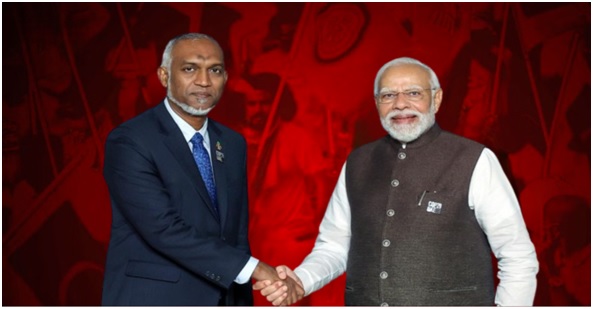
- 14 Oct 2023
Why is it in the News?
Following the recent presidential elections in Maldives, there are concerns about the potential impact on India-Maldives relations due to the 'India-Out' campaign led by President-elect Mohamed Muizzu.
Context:
- The recent election in Maldives resulted in the victory of a candidate perceived as Pro-China for the presidential role, sparking apprehensions for India.
- Maldives had a historical shift from an Executive Presidency system dating back to 1968 to a multi-party democracy in 2008.
- The absence of a re-elected incumbent president since 2008 is causing concern for India on this occasion.
Geographical Bonds Between India and Maldives:
- The Maldives is an archipelago spread across 90,000 square kilometres, predominantly comprising 99.6% of the ocean, leaving the remaining land scattered among over 1,200 islands.
- A concerning forecast by experts suggests that by 2050, 80% of the Maldives may face submersion due to the effects of 'Global Boiling.'
- In this geographical tapestry, India emerges as the closest neighbour, positioned just 70 nautical miles away.
- In times of crisis, it is India alone that stands as Maldives' immediate and unwavering ally.
- The profound words of Ibn Khaldun, the Tunisian philosopher, find resonance in the destiny woven by geography between these two nations.
- As he asserted, geography plays a pivotal role, and in the case of India and the Maldives, it s
How Has India Assisted the Maldives in the Past?:
- Essential Support and Communication Dependence: Historically, Maldives has leaned on India for essentials and communication, with India standing as a consistent and indispensable factor in the island nation's development.
- Even during the British protectorate years (1887-1965), Maldives relied on India for essentials and as a gateway to the outside world.
- State Bank of India's Role in Tourist Economy: India played a pivotal role in shaping Maldives' tourist economy, with the State Bank of India serving as a major financier in building the foundation of the country's tourism sector.
- This enduring support positions the State Bank of India as the largest bank in the Maldives to this day.
- Non-Interference in Internal Developments: Crucially, India has refrained from interfering in Maldives' internal affairs, offering support during critical moments such as the attempted coup in 1988 and subsequent assistance in various forms over the decades.
- The profound dependence of Maldives on India, coupled with India's unconditional support, has played a pivotal role in the island nation's emergence as the highest per capita country in South Asia.
- India's Prompt Response in Crises: During three major crises in 1988 (coup), 2004 (tsunami), and 2014 (water shortage), India emerged as the first responder, exemplifying its commitment to Maldives' well-being.
- Critical Role of Indian Professionals: In education and health, Indian teachers and doctors continue to play crucial roles, extending their influence even to remote inhabited islands.
- Strategic Defense Cooperation: The strategic defence cooperation between India and Maldives goes beyond material assistance, focusing on capacity building through joint exercises like Ekuverin and Ekatha, as well as collaboration in surveillance assets, training 1,400 MNDF trainers in recent years, and disaster management efforts.
What is the Current Situation of India-Maldives Bilateral Relations?
- India stands as the predominant partner in various sectors, be it trade or tourism.
- Demonstrating commitment to elevating Maldives' infrastructure, India is actively engaged in projects such as enhancing connectivity in Greater Male.
- India plays a vital role in supplying a diverse range of essential commodities in bulk, including rice, wheat flour, sugar, potatoes, onions, eggs, vegetables, and even special dispensations like river sand and construction materials.
India's Strategic Interests in Maldives:
- Strategic Significance: Maldives holds paramount importance for India as a primary line of defense against various threats, including terrorism, piracy, drug trafficking, narcotics, and maritime crimes.
- Geographically, Maldives is strategically positioned merely 70 nautical miles from Minicoy and 300 nautical miles from India's West coast.
- It serves as a pivotal point within the commercial sea lanes traversing the Indian Ocean.
- Geo-Political Alignment: India's interests in Maldives align on various fronts, encompassing:
- Securing sea lanes of communication.
- Combating piracy and sea-based terrorism.
- Transforming the Indian Ocean into a conflict-free zone, restoring its status as a peaceful maritime region.
- Exploring the potential of the blue economy and enhancing trade relations.
- Internal Security Concerns: Maldives' proximity and shared maritime borders have direct implications for India's internal security.
- The upsurge in Maldivians joining terrorist groups, such as the Islamic State (IS), poses a significant challenge.
- Political instability and socio-economic uncertainties contribute to the growth of Islamist radicalism, raising concerns about the potential use of remote Maldivian islands as launch pads for terror attacks against India and its interests.
What are the Challenges to India-Maldives Bilateral Relations?
- Rising Islamic Radicalization: The Maldives has witnessed an alarming increase in per capita numbers of individuals joining foreign terrorist groups in Syria and Iraq.
- A 2020 report by the European Foundation for South Asian Studies highlights the challenge of growing Islamic radicalization among the Maldivian population.
- India Out Campaign: The India Out campaign, supported by Maldives' opposition leader Abdulla Yameen and the newly elected president, projects a sceptical view of India's investments and defence partnerships.
- Allegations include concerns about compromising the sovereignty of the island nation by allowing Indian military presence, fostering a negative sentiment towards India's role as a net-security provider.
- The China Factor: China's engagement in the region is perceived as self-serving, characterized by debt financing leading to potential debt traps and China's expanding influence.
- Concerns arise over China's interference in Maldives' internal politics and support for conservative elements, posing a threat to the development of a vibrant democracy.
- There are apprehensions that elements aligning with China may perpetuate a legacy of controlled regimes from the Gayoom era, potentially compromising the nation's long-term interests.
Way Ahead for India-Maldives Relations: Detrimental Effects of Anti-India Campaigns
- India remains steadfast in its commitments to the Maldives, consistently investing in efforts to strengthen bilateral relations.
- Any hasty attempts to unravel this carefully nurtured partnership are poised to inflict more harm on the Maldives than on India itself.
- A telling example is the 2012 'GMR out' campaign, which cost Maldives a substantial $270 million payout to GMR.
- The Yameen era, marked by a pro-China policy, plunged Maldives into a debt crisis, underscoring the potential pitfalls of such geopolitical shifts.
Conclusion
Throughout the decades, India has been a reliable source of security assistance for Maldives, extending a hand of friendship and trust. It is anticipated that the newly elected President Muizzu will likely refrain from taking drastic measures that could alter the fabric of relations with India. While elections are often driven by emotions and promises, the pragmatic realities of governance may lead him to recognize the potential repercussions of undermining the longstanding ties with India.
